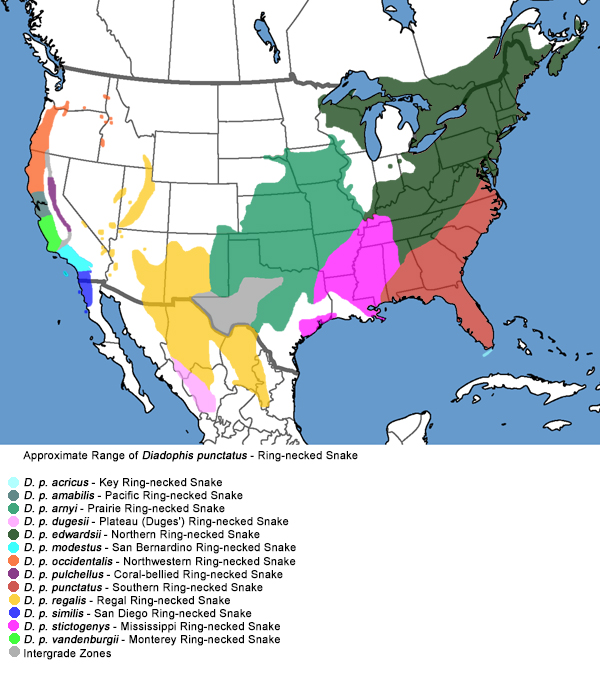
They can be found within open woodlands near rocky hillsides or in wetter environments with an abundant cover or woody debris within riparian and wet environments especially in more arid habitats. Their range extends from Nova Scotia southern Quebec and Ontario to south-central Mexico covering the entire eastern seaboard except for areas along the gulf coasts of south Texas and northeast Mexico.

Ring-necked snakes are found in forested areas including forest edges and clearings.
Ringneck snake habitat. Ring-necked snakes occur in a wide variety of habitats. They prefer areas with abundant cover and denning locations. They can be found within open woodlands near rocky hillsides or in wetter environments with an abundant cover or woody debris within riparian and wet environments especially in more arid habitats.
Where do Ringneck Snakes Live These snakes prefer areas with gently moistened soil located on the banks of rivers ponds or streams swamps damp forests open woodlands under-stone or under-bark coverage and rocky hillsides. Ring-necked snakes are found in forested areas including forest edges and clearings. These snakes are most common in areas with shallow soil and surface bedrock where they are frequently found under rocks logs or bark.
They hibernate underground and will also retreat underground during especially warm weather. Ringneck snakes can be found in virtually any habitat but seem to prefer wooded areas. In the Piedmont and Coastal Plain ringnecks are particularly common in moist areas including river floodplains moist hardwood forests and wetland edges.
Key ringneck snakes inhabit tropical hardwood hammock and scrub habitat types found within their small range on Key West Big Pine Little Torch Middle Torch and No Name Keys. The ring-necked snake is an attractive olive colored snake often found seeking refuge under rocks and logs. Much more common in areas of higher moisture they are found sporadically through the drier areas of Texas including some of the moister areas of the Chihuahuan Desert.
The Ringneck snake is one of the most common reptiles on the North American continent. The subspecies called the Northern Ringneck is found right here in Northern Virginia but thanks to an astounding variability of diet and habitat Ringnecks can also be seen all up and down the East Coast in Mississippi and out west in the prairies and throughout the Midwest. The ringneck snake is a species of slender mildly poisonous snakes commonly found in southeastern Canada central Mexico and many parts of the US.
Their small stature nonaggressive nature and rear-facing fangs do not pose much threat to the humans. Locality records from FLMNH and Florida Natural Areas Inventory for ringneck snakes in the Lower Keys. The Key ringneck snake inhabits pine rockland habitat and the edges of disturbed portions of rockland hammocks Lazell 1989 Weaver et al.
It seems to be restricted to areas near. Ringneck snakes are common reptiles that have a wide range of geographical distribution in North America. The snake is located in Canada Central and Eastern North America.
Their habitat extends from the Canadian provinces of Nova Scotia Southern Quebec Ontario down to southern Mexico. Key ringneck snakes inhabit tropical hardwood hammocks and scrub. This species is restricted to the Lower Keys and has been found on Key West and Big Pine Little Torch Middle Torch and No Name Keys Weaver et al.
1992 Auth and Scott 1996 museum records. Ringneck snakes are small snakes that live throughout North and Central America with a territory that spans from Canada all the way through Mexico. As the name implies the snakes have a distinctive yellow ring on their neck.
What Do Ringneck Snakes Eat. In their natural habitat in wet woodlands and near streams and ponds the ringneck eats small frogs salamanders and lizards as well as a variety of insects slugs and worms. They may even eat the baby snakes of.
Their favorite areas offer lots of ground cover for burrowing. Although they are versatile ring snakes thrive in wooded areas with moist soil. Being close to riverbeds and ponds are also popular spots.
Its common for ring snakes to live in dens with. The habitat of a ring snake Did you know that ringneck snakes have the largest geographic range in North America. They live throughout certain parts of the United States Canada and Mexico.
Their favorite areas offer lots of ground cover for burrowing. In the wild they can be found in swamps holes in the ground or along banks of rivers. A pool of water inside their enclosure is a good idea.
Ringneck snakes are tropical or semi-aquatic snakes. They thrive when humidity levels are between 50 and 80 percent so make sure you ensure this for their enclosure. Ringneck snakes are common snakes occurring throughout eastern and central North America.
Their range extends from Nova Scotia southern Quebec and Ontario to south-central Mexico covering the entire eastern seaboard except for areas along the gulf coasts of south Texas and northeast Mexico. This is a huge geographic range. It is one of Maines 9 species of non-venomous snakes.
Habitat Of The Ringsnake. The Ringneck snake loves leaves. It inhabits forests woodlands bushy areas logs hillsides grasslands rocky and moist areas.
It feeds on frogs lizards salamanders earthworms and other small snakes swallowing its prey whole. Ringneck Snake Diadophis punctatus. Metadata Data about data or how the map was made Legend.
Core Habitat Marginal Habitat. Predicted Distribution Reptiles do not migrate as some birds and mammals so the colored areas depict the predicted range for the Ringneck Snake year-round. The habitats were identified using 1991.
Keeping ring-neck snakes is relatively simple. A ten gallon tank will be suffice for 1 to 3 of them. They can eat worms small frogs and more.
Southern Ringneck punctatus Northern Ringneck edwarsii Mississippi Ringneck stictogenys Other Names none Conservation Status Global. S5 What does this mean.